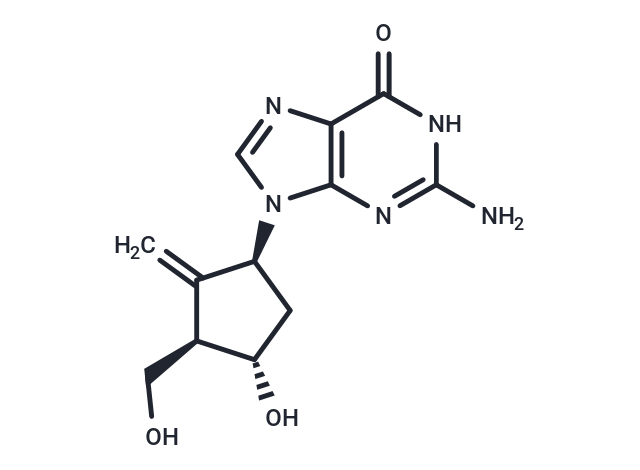Shopping Cart
- Remove All
 Your shopping cart is currently empty
Your shopping cart is currently empty

Entecavir (SQ34676) is a guanosine nucleoside analogue used in the treatment of chronic hepatitis B virus (HBV) infection. Entecavir therapy can be associated with flares of the underlying hepatitis B during or after therapy, but has not been linked to cases of clinically apparent liver injury.

| Pack Size | Price | Availability | Quantity |
|---|---|---|---|
| 5 mg | $43 | In Stock | |
| 10 mg | $79 | In Stock | |
| 25 mg | $118 | In Stock | |
| 50 mg | $169 | In Stock | |
| 100 mg | $297 | In Stock | |
| 200 mg | $455 | In Stock | |
| 500 mg | $733 | In Stock | |
| 1 mL x 10 mM (in DMSO) | $46 | In Stock |
| Description | Entecavir (SQ34676) is a guanosine nucleoside analogue used in the treatment of chronic hepatitis B virus (HBV) infection. Entecavir therapy can be associated with flares of the underlying hepatitis B during or after therapy, but has not been linked to cases of clinically apparent liver injury. |
| Targets&IC50 | HBV (HepG2 cells):3.75 nM(ec50) |
| In vitro | BMS-200475 demonstrates potent antiviral activity with an EC50 of 3.75 nM against HBV by integrating into the protein primer of HBV, thereby inhibiting the priming step of the virus's reverse transcriptase. Its efficacy is notably reduced against other RNA and DNA viruses[1]. Entecavir, compared to other deoxyguanosine analogs (penciclovir, ganciclovir, lobucavir, and aciclovir) or lamivudine, undergoes more efficient phosphorylation to its active metabolites. Additionally, entecavir has an intracellular half-life of 15 hours[2]. |
| In vivo | Administering BMS-200475 orally on a daily basis in doses between 0.02 and 0.5 mg/kg of body weight for a duration of one to three months significantly decreases the viremia level of woodchuck hepatitis virus (WHV) in chronically infected woodchucks[3]. |
| Cell Research | BMS 200475 is prepared in phosphate-buffered saline (PBS) and diluted with appropriate medium containing 2% fetal bovine serum. HepG2 2.2.15 cells are plated at a density of 5×105 cells per well on 12-well Biocoat collagen-coated plates and are maintained in a confluent state for 2 to 3 days before being overlaid with 1 mL of medium spiked with BMS 200475. Quantification of HBV was performed on day 10[1]. |
| Alias | SQ34676, BMS200475 |
| Molecular Weight | 277.28 |
| Formula | C12H15N5O3 |
| Cas No. | 142217-69-4 |
| Smiles | Nc1nc2n(cnc2c(=O)[nH]1)[C@H]1C[C@H](O)[C@@H](CO)C1=C |
| Relative Density. | 1.81g/cm3 |
| Storage | Powder: -20°C for 3 years | In solvent: -80°C for 1 year | Shipping with blue ice/Shipping at ambient temperature. | |||||||||||||||||||||||||||||||||||
| Solubility Information | DMSO: 55 mg/mL (198.36 mM), Sonication is recommended. | |||||||||||||||||||||||||||||||||||
| In Vivo Formulation | 5% DMSO+95% Saline: 1 mg/mL (3.61 mM), Sonication is recommended. Please add the solvents sequentially, clarifying the solution as much as possible before adding the next one. Dissolve by heating and/or sonication if necessary. Working solution is recommended to be prepared and used immediately. The formulation provided above is for reference purposes only. In vivo formulations may vary and should be modified based on specific experimental conditions. | |||||||||||||||||||||||||||||||||||
Solution Preparation Table | ||||||||||||||||||||||||||||||||||||
DMSO
| ||||||||||||||||||||||||||||||||||||

Copyright © 2015-2025 TargetMol Chemicals Inc. All Rights Reserved.